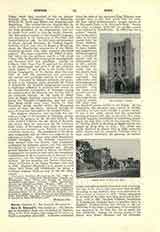

Bury St. Edmund’s, the Abbey of. The first religious foundation there was established by Sigebert, King of the East Angles, who resigned his crown to found a monastery about 637. It became celebrated when the relics of the martyred King Edmund were brought there in 903, after which time the town, till then called Beodericsworth, became known as St. Edmund’s Town or St. Edmund’s Bury. During the reign of Canute (1016-35) the secular canons were replaced by Benedictines. In 1095 there was a solemn translation of the saint’s relics to the new church built by Abbot Baldwin. The shrine grew in fame, wealth, and magnificence till the monastery was considered second only to Glastonbury, but in 1465 a terrible fire caused, irreparable loss to the church, from which it never recovered. The abbot had a seat in Parliament and possessed full jurisdiction over the town and neighborhood. There was accommodation, for eighty monks, but more than two hundred persons resided in the Abbey. At the dissolution, the revenues were valued at £2,366, equivalent to more than £20,000 in present money. It was in the abbey church that the memorable meeting of barons took place in the year 1214, when Cardinal Langton, Archbishop of Canterbury, standing at the high altar, read out the proposed. Charter of Liberties, which in the form of Magna Charta was signed by King John in 1215. The abbey was finally dissolved by Henry VIII in 1539, when the abbey church and the monastic buildings were in large measure destroyed, the gateway, an ancient bridge, and other scattered ruins alone now remaining. The fate of the saint’s relics has never been decided. According to one, tradition, they were abstracted by Prince Louis of France in 1217. Relics purporting to be those of the saint were long preserved at Toulouse, until in 1901, Cardinal Vaughan, Archbishop of Westminster, obtained leave to translate them to England. Doubts having been thrown on the authenticity of the relics, a commission of investigation was appointed by the Holy See, but no report has been published. Among the famous monks of the Abbey were Abbot Sampson and his chronicler Jocelin of Brakelond (d. 1211); John Boston de Bury, author and bibliographer (d. 1430); John Lydgate, poet (d. 1446), and Byfield who was burnt for heresy in 1530.
EDWIN BURTON

